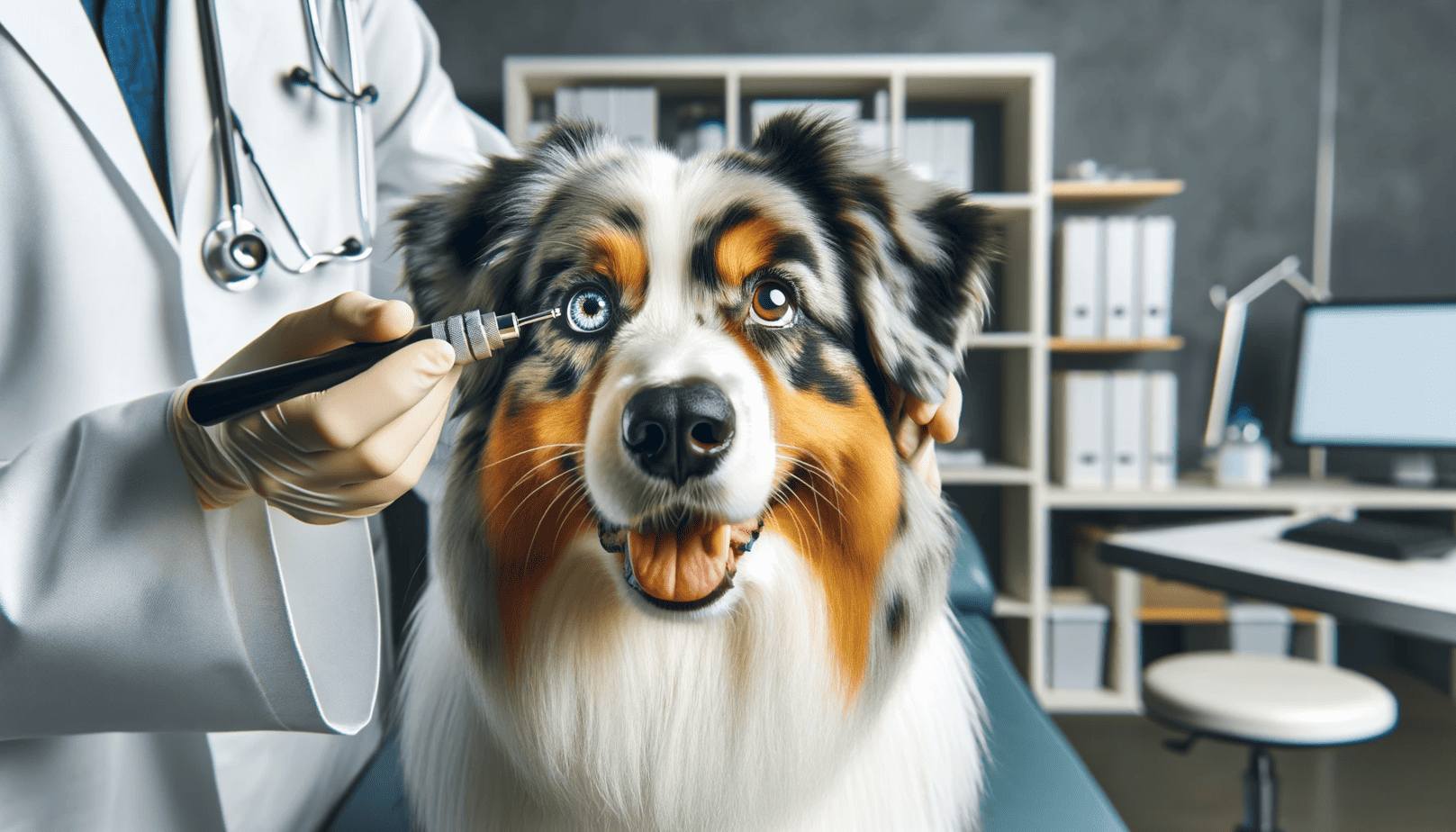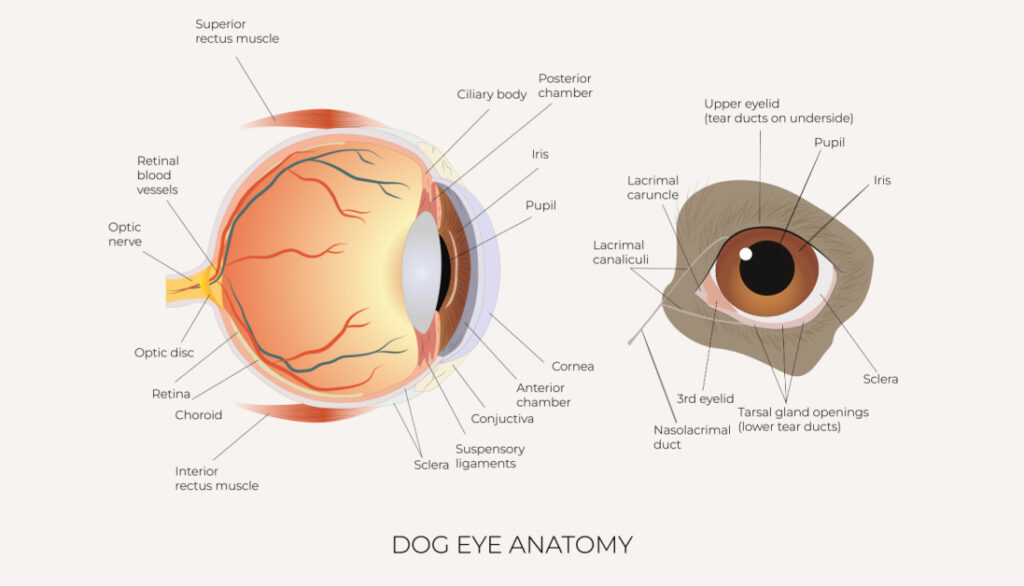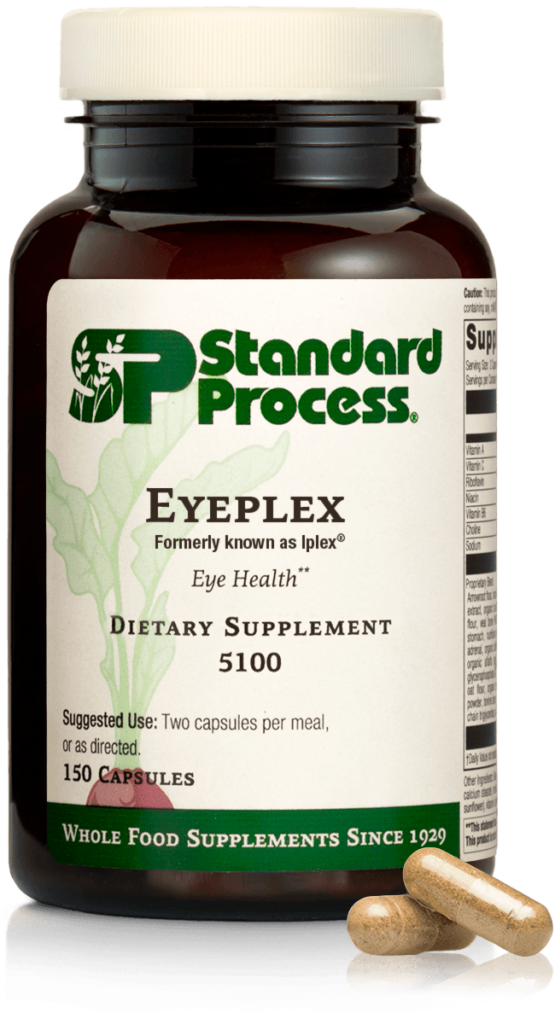Hello there, fellow dog lover! As a holistic veterinarian, I understand the deep bond you share with your Australian Shepherd. These loyal and energetic dogs are not just pets, but beloved family members. However, as with any breed, they are prone to certain health issues, particularly eye conditions. That’s why it’s important to learn about Australian Shepherd Eye Health – Conditions & Solutions From Vet.

Eye health is crucial for your Aussie’s quality of life. Unfortunately, this breed is predisposed to several eye diseases. But don’t worry, I’m here to guide you through understanding these conditions, and more importantly, how to prevent or manage them. From dietary modifications to routine eye care, there are numerous ways to protect your Aussie’s peepers.
Whether you’re dealing with an existing condition or hoping to prevent future issues, understanding Australian Shepherd Eye Health is a vital part of responsible pet ownership. So, let’s explore the common eye issues in Australian Shepherds, and discuss veterinary solutions for these problems. Together, we can ensure your Aussie’s eyes stay as bright and vibrant as their personality.
Remember, every dog is unique and deserves individualized care. So, let’s get started on this journey towards a healthier, happier life for your Australian Shepherd.

Understanding Australian Shepherd Eye Structure
Have you ever wondered what makes your Australian Shepherd’s eyes so captivating? Understanding the unique eye structure of your furry friend is the first step to ensuring their eye health. Let’s delve into the fascinating world of Australian Shepherd eye structure.
Australian Shepherds, often referred to as “Aussies,” possess a distinctive eye structure that sets them apart from other breeds. They have almond-shaped eyes that come in a variety of colors, including blue, brown, amber, green, or even a combination of these. This multi-colored phenomenon, known as heterochromia, is not only beautiful but also a hallmark trait of this breed.
Aside from their colorful appearance, the Australian Shepherd’s eyes are also structurally unique. They have a thick cornea – the clear, protective outer layer of the eye – which helps them to withstand the rigors of their active lifestyle. Additionally, Aussies have a well-developed tapetum lucidum, a layer of tissue in the eye that enhances night vision. This is a vestige of their herding ancestry, as it enabled them to work in low light conditions.
However, the unique eye structure of Australian Shepherds also predisposes them to certain health conditions. For instance, the breed is susceptible to congenital hereditary eye defects such as Collie Eye Anomaly (CEA) and Progressive Retinal Atrophy (PRA). These conditions can lead to vision impairment or even blindness if not addressed early.
As a responsible Aussie parent, it is crucial to understand these structural nuances. Regular veterinary check-ups can help detect any abnormalities in your dog’s eye structure, allowing for early intervention if necessary. Moreover, understanding your dog’s unique eye structure can help you cater to their specific needs, such as providing them with adequate lighting during the night or taking extra precautions during playtime to avoid eye injuries.

Common Eye Issues In Australian Shepherd
As a veterinarian, I often see Australian Shepherds struggle with several unique eye health problems. While it’s true that all dogs can suffer from eye issues, Australian Shepherds are particularly prone to certain conditions due to their genetic makeup. Understanding these common Australian Shepherd Eye Issues can help you identify problems early and seek prompt treatment.
Cataracts are one of the most common eye problems in Australian Shepherds. This condition causes cloudiness in the lens of the eye, which can lead to reduced vision or even blindness. Cataracts can be hereditary or caused by injury, diabetes, or old age.
Progressive Retinal Atrophy (PRA) is another common issue. This genetic disease causes the cells in the retina to deteriorate over time, leading to night blindness and eventually, total loss of vision. Unfortunately, there’s no cure for PRA, but early diagnosis can help manage the condition.
Collie Eye Anomaly (CEA) is a congenital condition that affects the development of the choroid, a layer of blood vessels in the eye. Dogs with CEA may have minor vision impairment or, in severe cases, can go blind.
Australian Shepherds can also suffer from Distichiasis, a condition where extra eyelashes grow from the oil glands of the eye and rub against the cornea. This can cause irritation, tearing, and corneal ulcers.
Lastly, Corneal Dystrophy is a condition that affects the cornea, causing it to become opaque. This can lead to vision problems, especially if the dystrophy progresses.
It’s crucial to remember that Australian Shepherd Eye Health – Conditions & Solutions From Vet often depend on early detection. Regular eye exams can help identify issues before they become severe. If you notice any changes in your dog’s eyes, such as cloudiness, redness, excessive tearing, or changes in vision, don’t hesitate to reach out to your vet.

Nourishing Your Dog’s Vision: Essential Nutrients for Eye Health
Ensuring your Australian Shepherd gets the right nutrients for optimal eye health is essential for maintaining clear vision and preventing age-related issues. Natural, nutrient-rich foods and supplements can play a key role in supporting their eyesight. From vitamin A-packed freeze-dried liver treats to antioxidant-rich blueberries and targeted supplements like Eyeplex by Standard Process, there are several ways to nourish your dog’s eyes. In this section, we’ll explore how these powerful ingredients contribute to long-term vision health and overall well-being.
Eyeplex by Standard Process
Eyeplex by Standard Process is a specialized supplement designed to support your Australian Shepherd’s eye health with a blend of essential nutrients. Formulated with key vitamins, minerals, and antioxidants, Eyeplex helps protect against oxidative stress, supports retinal function, and promotes overall vision health. Ingredients like vitamin A, vitamin C, and zinc contribute to maintaining strong eyesight, while whole food ingredients provide additional phytonutrients for cellular protection. Adding Eyeplex to your Australian Shepherd’s diet can be especially beneficial for aging dogs or breeds prone to eye conditions, offering targeted nutritional support to keep their vision sharp and healthy for years to come.

Freeze-Dried Blueberries
Freeze-dried blueberries are a powerhouse of antioxidants that can help protect your Australian Shepherd’s eyes from oxidative stress and age-related damage. Rich in vitamins C and E, as well as anthocyanins, these tiny but mighty berries help combat free radicals that can contribute to eye diseases like cataracts and macular degeneration. Incorporating freeze-dried blueberries into your dog’s diet provides a natural and delicious way to support retinal health, reduce inflammation, and promote overall vision longevity. Plus, they’re a low-calorie, dog-friendly treat that makes a great addition to a balanced diet for long-term eye health.

Freeze-Dried Liver
Freeze-dried liver treats are an excellent natural source of vitamin A, an essential nutrient for your Australian Shepherd’s eye health. Vitamin A plays a crucial role in maintaining good vision, especially in low-light conditions, while also supporting overall immune function and skin health. Since liver is rich in bioavailable vitamin A, incorporating freeze-dried liver treats into your dog’s diet provides a convenient and nutritious way to promote optimal eye function. Just be sure to feed them in moderation, as excessive vitamin A can lead to toxicity. Adding these nutrient-packed treats to your pup’s routine is a simple, tasty way to support their long-term vision and well-being!

By prioritizing your Australian Shepherd’s eye health through a balanced diet and nutritional supplements, you can help prevent many common eye issues. These simple steps can go a long way in ensuring your pup’s eyes stay healthy and clear for years to come.
Environmental Hygiene To Reduce Eye Problems
Environmental hygiene plays a crucial role in maintaining the eye health of your Australian Shepherd. A clean and safe environment can significantly reduce the risk of eye problems in your furry friend. Let’s discuss some key aspects of environmental hygiene that can help prevent eye issues.
Indoor Air Quality
Indoor air quality is a major factor that can impact your Australian Shepherd’s eye health. Poor air quality can lead to irritation and dryness in the eyes, making your pet more susceptible to infections and diseases. Here are some ways you can improve the indoor air quality:
- Regular Cleaning: Regularly clean your home to reduce dust and allergens. Vacuum carpets, rugs, and upholstery regularly, and wash your pet’s bedding frequently.
- Air Purifiers: Consider using an air purifier to filter out harmful particles and allergens from the air.
- Adequate Ventilation: Ensure your home is well-ventilated. Open windows and doors for fresh air circulation.
Sprays, Diffusers, Candles, Incense
While sprays, diffusers, candles, and incense can make your home smell great, they can be harmful to your Australian Shepherd’s eyes. The chemicals and fragrances used in these products can cause eye irritation, leading to discomfort and potential eye problems. Here’s what you can do:
- Choose Natural Products: Opt for products made with natural ingredients. Avoid products with strong fragrances and harsh chemicals.
- Placement: Keep these products out of your pet’s reach and away from areas where your pet spends a lot of time.
- Use Sparingly: Use these products sparingly. Excessive use can lead to a buildup of harmful particles in the air.
Remember, your Australian Shepherd’s eye health is not just about regular check-ups and treatments. It’s about creating an environment that supports their overall well-being. By maintaining good environmental hygiene, you can help prevent eye problems and ensure your Australian Shepherd has a healthy and happy life.
Routine Australian Shepherd Eye Care & Maintenance
As a responsible Australian Shepherd parent, you should prioritize proper eye care and maintenance to prevent health issues and ensure your furry friend’s overall well-being. This section will provide you with helpful tips and guidelines on how to maintain your Australian Shepherd’s eye health.
Daily & Weekly Care & Maintenance
Regular eye care is crucial for your Australian Shepherd. Daily check-ups can help detect any abnormalities or signs of eye diseases early, allowing for prompt treatment. Use a clean, damp cloth to gently wipe around your dog’s eyes, removing any discharge or debris that may have accumulated.
Weekly, examine your dog’s eyes closely. Look for redness, cloudiness, or any changes in the eye’s size or shape. If you notice anything unusual, contact your vet immediately.
When bathing your Australian Shepherd, avoid getting soap or shampoo in their eyes as this can cause irritation. Instead, use a damp washcloth to carefully clean around the eye area.
Monitor Hair Length, Nail Length, Bath Frequency
Keeping your Australian Shepherd well-groomed is another crucial aspect of maintaining their eye health. Long hair can irritate the eyes, leading to inflammation and potential infection. Regularly trim the hair around your dog’s eyes to prevent this issue.
Similarly, long nails can pose a risk to your dog’s eyes. Dogs often scratch their faces, and long nails can inadvertently scratch the eye surface, causing injury. Keep your dog’s nails trimmed to a safe length to avoid this risk.
Bathing frequency also plays a role in your dog’s eye health. Over-bathing can lead to dry skin and irritation, which can affect the eyes. On the other hand, infrequent bathing can lead to a buildup of dirt and bacteria, potentially causing infections. Find a balance that works for your dog, taking into account their activity level and skin condition.
Remember, your Australian Shepherd’s eye health is an essential aspect of their overall well-being. By following these tips and maintaining a regular care routine, you can help ensure that your furry friend enjoys a life free from eye problems.
Frequently Asked Questions
1. What are common eye conditions in Australian Shepherds?
Australian Shepherds are prone to several eye conditions, including cataracts, progressive retinal atrophy (PRA), collie eye anomaly (CEA), and distichiasis.
2. How can I identify if my Australian Shepherd has an eye problem?
Watch out for signs such as excessive tearing, redness, cloudiness, squinting, bumping into objects, or changes in behavior related to vision. If you notice any of these symptoms, it is important to consult a veterinarian for a proper diagnosis.
3. Can eye conditions in Australian Shepherds be treated?
The treatment options for eye conditions in Australian Shepherds depend on the specific condition. Some conditions may require surgical intervention, while others can be managed with medications or lifestyle adjustments. It is essential to consult with a veterinarian to determine the best course of action.
4. How can I prevent eye problems in my Australian Shepherd?
To reduce the risk of eye problems, it is crucial to maintain regular veterinary check-ups and eye examinations. Additionally, providing a balanced diet, protecting your dog’s eyes from injury, and avoiding exposure to harmful chemicals or irritants can help promote good eye health.
5. Are Australian Shepherds more prone to certain eye conditions than other breeds?
Australian Shepherds have a higher predisposition to certain eye conditions, such as cataracts and PRA, compared to some other breeds. However, it is important to note that individual dogs may vary, and not all Australian Shepherds will develop these conditions.
